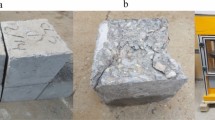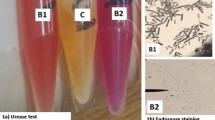Abstract
Microbial-based self-healing of concrete represents innovative technology for improving micro-crack sealing. Microbial bioactivity can induce calcite-precipitation in concrete, which seals micro-cracks. In this respect, two Egyptian bacterial isolates were selected and identified, as Bacillus subtilis (Bs) and Bacillus megaterium (Bm) using MALDI-TOF/MS-Biotyper®. Peak patterns of the bacterial ribosomal proteins showed a high match between samples and standards, which verified species consistency. Bs and Bm were added to the mortar mixture in two concentrations (0.5%, 1%) of cement weight, then the mechanical and physical properties were tested throughout a 180-day time course. The compressive strength of Bm0.5 bacterial mortar samples was increased by 21.4% after 28 days, as compared to control. The rate of water absorption of Bm samples was decreased by 12.4% after 180 days. Bacterial mortar samples showed significant restoration of compressive strength than the original samples by 44%, 21%, and 52.6% for Bs1, Bm0.5, and Bs0.5, respectively. SEM and EDAX analyses confirmed that bacterial samples were denser with fewer voids than the control, as a result of microbial nanosized calcite-precipitation. DTA verified that the amount of CaCO3 and its degree of crystallinity were increased in the bacterial mortar samples. Load–deflection of reinforced-laminates for bacterial mortar samples showed ductile behavior and less deformation as compared to control. In this work, novel concrete with improved mechanical and physical properties has been developed using selected Egyptian microorganisms, it can promote self-healing of micro-cracks with improved durability of the concrete. The application of self-healing bioconcrete can reduce the inspection and maintenance costs.









Similar content being viewed by others
References
Abalaka AE (2011) Effects of sugar on physical properties of ordinary Portland cement paste and concrete. AU JT 14(3):225–228
Achal V, Mukherjee A, Reddy MS (2011) Microbial concrete: way to enhance the durability of building structures. J Mater Civ Eng 23(6):730–734
Al-Tabbaa A, Litina C, Giannaros P, Kanellopoulos A, Souza L (2019) First UK field application and performance of microcapsule-based self-healing concrete. Constr Build Mater 208:669–685
Anne S, Rozenbaum O, Andreazza P, Rouet JL (2010) Evidence of a bacterial carbonate coating on plaster samples subjected to the calcite bioconcept biomineralization technique. Constr Build Mater 24(6):1036–1042
Barabesi C, Galizzi A, Mastromei G, Rossi M, Tamburini E, Perito B (2007) Bacillus subtilis gene cluster involved in calcium carbonate biomineralization. J Bacteriol 189(1):228–235
Cacchio P, Ercole C, Cappuccio G, Lepidi A (2003) Calcium carbonate precipitation by bacterial strains isolated from a limestone cave and from a loamy soil. Geomicrobiol J 20(2):85–98
Castanier S, Le Métayer-Levrel G, Orial G, Loubière JF, Perthuisot JP (2000) Bacterial carbonatogenesis and applications to preservation and restoration of historic property. Springer, Boston
Chahal N, Siddique R, Rajor A (2012) Influence of bacteria on the compressive strength, water absorption and rapid chloride permeability of fly ash concrete. Constr Build Mater 28(1):351–356
Ferrocement Model Code, reported by IFS Committee 10, January 2001 (c) Commentary
Daskalakis MI, Rigas F, Bakolas A, Magoulas A, Kotoulas G, Katsikis I, Karageorgis AP, Mavridou A (2015) Vaterite bio-precipitation induced by Bacillus pumilus isolated from a solutional cave in Paiania, Athens, Greece. Int Biodeterior Biodegradation 99:73–84
De Muynck W, Debrouwer D, De Belie N, Verstraete W (2008) Bacterial carbonate precipitation improves the durability of cementitious materials. Cem Concr Res 38(7):1005–1014
Dhami NK, Reddy SM, Mukherjee A (2012). Biofilm and microbial applications in biomineralized concrete. Advanced Topics in Biomineralization, 137–164
Dick J, De Windt W, De Graef B, Saveyn H, Van der Meeren P, De Belie N, Verstraete W (2006) Bio-deposition of a calcium carbonate layer on degraded limestone by Bacillus species. Biodegradation 17(4):357–367
Du W, Yu J, Gu Y, Li Y, Han X, Liu Q (2019) Preparation and application of microcapsules containing toluene-di-isocyanate for self-healing of concrete. Constr Build Mater 202:762–769
Dupraz C, Reid RP, Braissant O, Decho AW, Norman RS, Visscher PT (2009) Processes of carbonate precipitation in modern microbial mats. Earth Sci Rev 96(3):141–162
Egyptian Standard Specifications (2007). "Composition, specifications and conformity criteria for common cements", Part 1, [ES, 4756–1, 2007]
El-Turki A, Ball RJ, Holmes S, Allen WJ, Allen GC (2010) Environmental cycling and laboratory testing to evaluate the significance of moisture control for lime mortars. Constr Build Mater 24(8):1392–1397
Erşan YÇ, Da Silva FB, Boon N, Verstraete W, De Belie N (2015) Screening of bacteria and concrete compatible protection materials. Constr Build Mater 88:196–203
Ferrara L, Van Mullem T, Alonso MC, Antonaci P, Borg RP, Cuenca E, De Belie N (2018) Experimental characterization of the self-healing capacity of cement based materials and its effects on the material performance: a state of the art report by COST Action SARCOS WG2. Constr Build Mater 167:115–142
Gandhimathi A, Suji D, Rajesh R, Elayarajah B (2015) Potential application of bacterial inoculum to increase different mechanical strength in the prepared concrete. Int J Innov Res Sci Eng Technol 4:1176–1181
Ghosh T, Bhaduri S, Montemagno C, Kumar A (2019) Sporosarcina pasteurii can form nanoscale calcium carbonate crystals on cell surface. PLoS ONE 14(1):1–15
Givi AN, Rashid SA, Aziz FNA, Salleh MAM (2011) The effects of lime solution on the properties of SiO2 nanoparticles binary blended concrete. Compos B Eng 42(3):562–569
Gupta S, Kua HW, Dai Pang S (2008) Healing cement mortar by immobilization of bacteria in biochar: an integrated approach of self-healing and carbon sequestration. Cement Concr Compos 86:238–254
https://www.statista.com/statistics/507174/egypt-production-of-cement/retrived April 1, 2019
Hung CC, Su YF (2016) Medium-term self-healing evaluation of engineered cementitious composites with varying amounts of fly ash and exposure durations. Constr Build Mater 118:194–203
Jonkers HM, Thijssen A, Muyzer G, Copuroglu O, Schlangen E (2010) Application of bacteria as self-healing agent for the development of sustainable concrete. Ecol Eng 36(2):230–235
Jonkers HM, Palin D, Flink P, Thijssen A (2013) Microbially mediated carbonation of marine alkaline minerals: potential for concrete crack healing. Construction and Building Materials, UK
Jroundi F, Fernández-Vivas A, Rodriguez-Navarro C, Bedmar EJ, González-Muñoz MT (2010) Bioconservation of deteriorated monumental calcarenite stone and identification of bacteria with carbonatogenic activity. Microb Ecol 60(1):39–54
Khaliq W, Ehsan MB (2016) Crack healing in concrete using various bio influenced self-healing techniques. Constr Build Mater 102:349–357
Lea FM "The Chemistry of Cement and Concrete", 1988, 3rd ed., London, Edward Arnold, UK
Li V (2009) Self-healing concrete for safer, more durable infrastructure. University of Michigan
Li VC, Yang EH (2007) Self-healing in concrete materials. Self-healing materials. Springer, Dordrecht
Marvin LF, Roberts MA, Fay LB (2003) Matrix-assisted laser desorption/ionization time of-flight mass spectrometry in clinical chemistry. Clin Chim Acta 337(1):11–21
Narayanan N, Ramamurthy K (2000) Structure and properties of aerated concrete: a review. Cement Concr Compos 22(5):321–329
Park SJ, Park JM, Kim WJ, Ghim SY (2012) Application of Bacillus subtilis 168 as a multifunctional agent for improvement of the durability of cement mortar. J Microbiol Biotechnol 22(11):1568–1574
Ramachandran VS, Paroli RM, Beaudoin JJ, Delgado AH (2002) Handbook of thermal analysis of construction materials, Institute for research in construction NRC. Institute for Research in Construction National Research Council of Canada, Canada
Ramadas A, Shobana K, Samuel TM (2019) ‟A review on self-healing concrete”. Int Res J Engin Technol 6(3):762–766
Rodriguez-Navarro C, Rodriguez-Gallego M, Chekroun KB, Gonzalez-Munoz MT (2003) Conservation of ornamental stone by Myxococcus xanthus-induced carbonate biomineralization. Appl Environ Microbiol 69(4):2182–2193
Ryparová P, Prošek Z, Schreiberová H, Bílý P, Tesárek P (2021) The role of bacterially induced calcite precipitation in self-healing of cement paste. J Build Eng 19:102299
Sangadji S, Wiktor VAC, Jonkers HM, Schlangen HEJG (2013). Injecting a liquid bacteria-based repair system to make porous network concrete healed. In ICSHM 2013: Proceedings of the 4th International Conference on Self-Healing Materials, Ghent, Belgium, June 16–20, 2013. Ghent University; Delft University of Technology
Sauer S, Freiwald A, Maier T, Kube M, Reinhardt R, Kostrzewa M, Geider K (2008) Classification and identification of bacteria by mass spectrometry and computational analysis. PLoS ONE 3(7):e2843
Schlangen E, Joseph C (2009). Self-healing processes in concrete. Self-healing materials: fundamentals, design strategies, and applications. Weinheim: Wiley-VCH verlag GmbH and Co KGaA: 141–182
Schwantes-Cezario N, Porto MF, Sandoval G, Nogueira G, Couto A, Toralles BM (2019) Effects of Bacillus subtilis biocementation on the mechanical properties of mortars. Revista IBRACON de Estruturas e Materiais 12(1):31–38
Seng P, Rolain JM, Fournier PE, La Scola B, Drancourt M, Raoult D (2010) MALDI-TOF-mass spectrometry applications in clinical microbiology. Future Microbiol 5(11):1733–1754
Siddique R, Singh K, Singh M, Corinaldesi V, Rajor A (2016) Properties of bacterial rice husk ash concrete. Constr Build Mater 121:112–119
Tiano P, Biagiotti L, Mastromei G (1999) Bacterial bio-mediated calcite precipitation for monumental stones conservation: methods of evaluation. J Microbiol Methods 36(1–2):139–145
Tziviloglou E, Wiktor V, Jonkers HM, Schlangen E (2016) Bacteria-based self-healing concrete to increase liquid tightness of cracks. Constr Build Mater 122:118–125
Vijay K, Murmu M, Deo SV (2017) Bacteria based self-healing concrete–a review. Constr Build Mater 152:1008–1014
Wang J, TittelboomK V, De Belie N, VerstraeteW, (2012) Use of silica gel or polyurethane immobilized bacteria for self-healing concrete. Constr Build Mater 26(1):532–540
Wang J, Dewanckele J, Cnudde V, Van Vlierberghe S, Verstraete W, De Belie N (2014) X-ray computed tomography proof of bacterial-based self-healing in concrete. Cement Concr Compos 53:289–304
Wieser A, Schubert S (2016) MALDI-TOF MS entering the microbiological diagnostic laboratory–from fast identification to resistance testing. Trends Anal Chem 84:80–87
Wiktor V, Jonkers HM (2011) Quantification of crack-healing in novel bacteria-based self-healing concrete. Cement Concr Compos 33(7):763–770
Xu J, Wang X (2018) Self-healing of concrete cracks by use of bacteria-containing low alkali cementitious material. Constr Build Mater 16:71–14
Xu J, Tang Y, Wang X, Wang Z, Yao W (2020) Application of ureolysis-based microbial CaCO3 precipitation in self-healing of concrete and inhibition of reinforcement corrosion. Constr Build Mater 265:120364
Zahran MA, Attia M, Nasser AA (2014) Self-healing of cracked concrete with bacterial approach. Eng Res J 37(2):255–264
Author information
Authors and Affiliations
Corresponding author
Ethics declarations
Conflict of interest
All authors declare that there are no financial/commercial conflicts.
Supplementary Information
Below is the link to the electronic supplementary material.
Rights and permissions
About this article
Cite this article
Ahmed, S.O., Nasser, A.A., Abbas, R.N. et al. Production of bioconcrete with improved durability properties using Alkaliphilic Egyptian bacteria. 3 Biotech 11, 231 (2021). https://doi.org/10.1007/s13205-021-02781-0
Received:
Accepted:
Published:
DOI: https://doi.org/10.1007/s13205-021-02781-0




